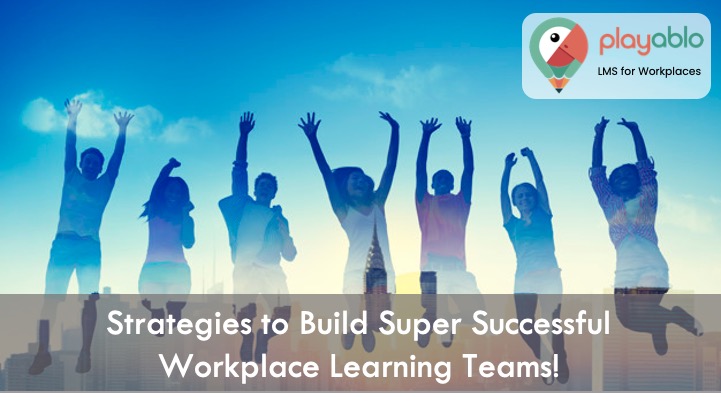What is the primary purpose of successful workplace learning teams? It is to effectively curate innovative online learning programs — at the right time, with the right quality, and in the correct quantity. And to help your eLearning team reach their maximum potential, you need to groom them correctly. How? Here are eight tried and tested strategies that will enable you to develop your very own L&D dream team.
Table of Contents
8 Strategies to Build Super Successful Workplace Learning Teams
The major challenge faced by training managers in organisations is with the production teams. The latter is often under too much stress to create volumes of learning materials in short time frames. But under such time constraints, it is challenging to produce quality online learning content that meets the needs of users and business stakeholders. Therefore, as an L&D leader, it is your responsibility to help your team stick to deadlines while curating effective, intelligent solutions. Your team also needs to be kept engaged, motivated, and people-centred. So, let’s explore how to go ahead with developing successful workplace learning teams.
Read More: New to L&D Department? Here is How to Chart Your Career in Workplace Learning!
How to Build Successful Workplace Learning Teams?
1.Define a Clear Organisational Learning Goal

To create successful workplace learning teams, your members need to be clear about what they are aiming for. If you are developing online learning materials in-house or in collaboration with reputed LMS providers like PlayAblo, you must have a clear vision for what ‘great eLearning’ looks like. First up, start by designing a manifesto and ensure that everyone commits to it. This document must include aspects like your end audience and analytics—research by digging out data that has worked well in the past. Conduct user surveys and interviews, and find out which elements improve performance. Finally, define a clear vision for your eLearning program.
How can you set some clear, practical objectives for your learning program? By offering best practice examples of elearning based on your findings. You can use your experiential designs and reusable single-page performance support resources to design prototypes of each. Enable your team to view, re-use, and adapt these models. The next step is to apply these examples to create user profiles and requirements so that your team understands how to help people.
2. Successful Workplace Learning Teams MUST Represent End-users
People-centred eLearning programs fully embrace the needs of end-users and represent them throughout the entire process. And your target audience is your learner base. When you set up your team, you need to empower them to talk with and involve trainees, check the associated analytics, and gauge user needs.
If a subject matter expert or manager creates roadblocks, make a detailed case explaining why connecting designers to end-users and goals are essential. Also, provide your team with templates and guides to quickly design, plan, and enhance the content. Additionally, equip them with ready-made user profiles to use such personas as a starting point to kickstart the process.
Read More: What Should Today’s Workplace Learning Team Structure Look Like?
3. Select the Right Roles That Meet Your Vision
It’s a no-brainer to create digital learning by using the authoring tools available in the market. However, it’s also necessary to consider the skills and support you need to meet your vision. Understand how you can engage audiences with in-house eLearning and impress them with fresh, spectacular experiences.
To complement your vision, you will need copywriting and strong visual design skills and an expert to design that learning experience. The key to creating successful workplace learning teams is to think of people in terms of roles, not jobs. The icing on the cake is when you recruit individuals who hold expertise in multiple roles. You can also include specialists from other teams when needed.
The six critical roles for your elearning team are the learning leader, the authoring tool expert, the eLearning designer, the subject matter expert, the graphics and media expert, and the copywriting expert. In a nutshell, how you configure your team will depend on your vision, the scale you are working at, and the skill-sets available to you.

4. Make the Right Investments
If you decide to jump in straight into the eLearning process, you will face obstacles. Instantaneous approaches can waste time, especially when working at scale. It leads to repetitive mistakes and inefficiencies, resulting in a very sporadic experience for users. Learners may get frustrated when they see that menus and buttons are repositioned and redesigned unnecessarily every time. Hence, make the suitable investment at the right time. When you invest early in your team to ensure they have the right skills, confidence, and competence, you will notice that such measures reap more benefits in the long run.
For instance, invest in hands-on training for your authoring platform and digital learning design skills where needed. Moreover, equip your teams with tools and support, which allow them to work smartly with content experts and stakeholders. For super successful workplace learning teams, you also have to incorporate expert coaching!
5. Reuse and Recycle
We always believe in smart working. There is no point in configuring a team from scratch every time. Think of how you can re-use global styles, layouts, pages, menus, even whole topics. For instance, our experts at PlayAblo can easily help you revamp your legacy PPT content to design a fresh micro-learning experience.
You can additionally add new designs to a central repository. Alongside prototypes to support your eLearning vision, continuously review and share best practice designs. Finally, it would help if you hosted re-usable guides and briefing packs. This approach is one of the best strategies to recreate successful workplace learning teams.
Ad: PlayAblo’s Enterprise-Grade Micro-Learning platform is for the modern corporate learner. Moreover, micro-Learning, along with assessments and gamification features, ensures learning outcome measurement along with sustained engagement.
Find out more and request a custom demo!
Read More: Your Go-to Guide to Convert PPT to Mobile Learning
6. Go Commercial
Try to get commercial about your eLearning production, even if your content is not for sale. It enables everyone to focus on value. After all, what drives better design results and more competent working? A quantifiable result. If you have department managers commissioning elearning projects for your team, assume the role of a consultative lead.
Gauge if the business is critical, what is it fore, and what is its shelf-life? What are the issues, and is your training program the apt solution? Have ready-made investment models in place and create easily understandable financial prototypes. Showcase, on average, how long and how much it takes to produce different kinds of results. Set team targets so that they know about the number of budgeted days and targeted media spend. The result? Successful workplace learning teams!
7. Promote a Community Spirit
Teams that work together create more efficient, faster, and better results. Promote sharing, peer- reviews, joint brainstorming, project re-use, and inspiration sessions through a community of practice. Don’t allow your teams to work in silos. Make them a part of big teams and include an online community portal or forum—Foster a community of practice for sharing, reviewing, seeking answers, and sharing data insights. Encourage peer review at a minimum of two stages — the initial design stage and when the training module goes live.
8. Don’t Miss Out on Data Analysis
Rarely do L&D leaders make data-based changes after an eLearning project has gone live. Equip your learning team with numbers and insightful analytics so that they can monitor what’s working and what’s not. It also enables them to make changes to up the project’s engagement and reach. Make it part of their role that they should make changes beyond launch, and ask them to report back on how it’s doing. At a macro level, ensure your learning leaders and managers are looking at data feeds across projects.
Rounding It Up
We hope the above tips will help you in designing the perfect successful workplace learning teams! For more info, you can always consult our experts here at PlayAblo!
Ad: PlayAblo’s Enterprise-Grade Micro-Learning platform is for the modern corporate learner. Moreover, micro-Learning, along with assessments and gamification features, ensures learning outcome measurement along with sustained engagement.
Find out more and request a custom demo!






